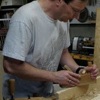OK, hot on the heels of my last discussion about 300-400 grit stones, I have another sharpening question for the collective. As some of you may know, I'm a high school shop teacher. For the last few years I have been sharpening my chisels and irons on a belt sander and then honing on a felt wheel. It's quick, but leaves a lot to be desired in terms of edge quality. I also can't turn the students loose because they would grind everything blue and down to a nub pretty quickly. I'll show you our lathe chisels some time...
What I'm looking for are stone(s) that are not expensive, durable, not fussy and will give a "good enough" edge, and something I can show the students how to use as well. We'll probably use an Eclipse style honing guide. These are 16 year old kids, remember. I'm starting to think Spyderco, but I'm open to suggestion, and to tell the truth, a pair of Spyderco stones is a little more than what I want to spend, especially considering I'll probably buy several sets. My budget is pretty limited.
Thanks again.





 Reply With Quote
Reply With Quote






